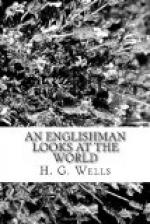Essentially this type of association presents a localised community, a community of which the greater proportion of the individuals are engaged more or less directly in the cultivation of the land. With this there is also associated the grazing or herding over wider or more restricted areas, belonging either collectively or discretely to the community, of sheep, cattle, goats, or swine, and almost always the domestic fowl is commensal with man in this life. The cultivated land at least is usually assigned, temporarily or inalienably, as property to specific individuals, and the individuals are grouped in generally monogamic families of which the father is the head. Essentially the social unit is the Family, and even where, as in Mohammedan countries, there is no legal or customary restriction upon polygamy, monogamy still prevails as the ordinary way of living. Unmarried women are not esteemed, and children are desired. According to the dangers or securities of the region, the nature of the cultivation and the temperament of the people, this community is scattered either widely in separate steadings or drawn together into villages. At one extreme, over large areas of thin pasture this agricultural community may verge on the nomadic; at another, in proximity to consuming markets, it may present the concentration of intensive culture. There may be an adjacent Wild supplying wood, and perhaps controlled by a simple forestry. The law that holds this community together is largely traditional and customary and almost always as its primordial bond there is some sort of temple and some sort of priest. Typically, the temple is devoted to a local god or a localised saint, and its position indicates the central point of the locality, its assembly place and its market. Associated with the agriculture there are usually a few imperfectly specialised tradesmen, a smith, a garment-maker perhaps, a basket-maker or potter, who group about the church or temple. The community may maintain itself in a state of complete isolation, but more usually there are tracks or roads to the centres of adjacent communities, and a certain drift of travel, a certain trade in non-essential things. In the fundamentals of life this normal community is independent and self-subsisting, and where it is not beginning to be modified by the novel forces of the new times it produces its own food and drink, its own clothing, and largely intermarries within its limits.
This in general terms is what is here intended by the phrase the Normal Social Life. It is still the substantial part of the rural life of all Europe and most Asia and Africa, and it has been the life of the great majority of human beings for immemorial years. It is the root life. It rests upon the soil, and from that soil below and its reaction to the seasons and the moods of the sky overhead have grown most of the traditions, institutions, sentiments, beliefs, superstitions, and fundamental songs and stories of mankind.




